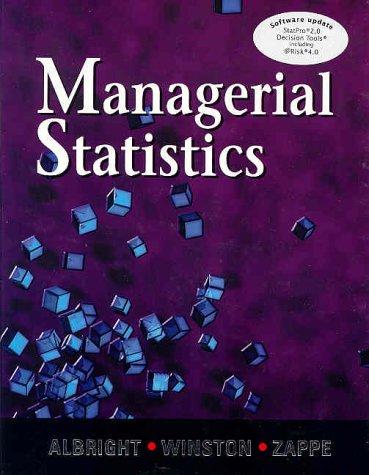Question
You are the manager of a consulting service. You have come across a potential employee that you believe will add value to the firm by
You are the manager of a consulting service. You have come across a potential employee that you believe will add value to the firm by attracting and serving more clients. The firm has given you the flexibility to add this employee to the staff. However, your bonus is based on full absorption after-tax firm performance. You expect the new employee to bring in the following revenues and associated incremental costs:
Period 1Period 2Period 3
Number of "jobs" started100125125
Number of "jobs" completed75100150
Variable cost per "job"$200$200$200
Selling and Administrative costs$10,000$10,000$10,000
New employee salary (to "jobs")$175,000$175,000$175,000
Selling price per "job"$2,000$2,000$2,000
All costs are applied to the jobs when they are started, but the revenues are not earned (the job is not sold) until the job is complete. Assume that the new employee salary is a direct input for the "jobs", but does not vary with the number of "jobs" (like a fixed overhead). The consulting service uses full absorption costing for both book and tax purposes. The "inventory system" is first in first out (FIFO). The discount rate for the firm is 12% and the tax rate is 30%. Assume that all costs (including salary and taxes) are paid in cash at the end of the year in which they occur and the clients pay their fees in cash at the end of the year in which the job is completed. Also, assume that there is no tax paid or tax credit if the reported income is less than 0. When necessary, discount all cash flows to the beginning of period 1 (note that all cash paid and received in period 1 must be discounted 1 period, Period 2 discounted 2 periods, and Period 3 discounted three periods).
(Note: For the questions below, ignore other income sources the firm may have, i.e. only consider the projects described above, facilitated by the new employee)
The present value of 1$ at the discount rate of 12% is follows:
Period Present Value of 1$
1 0.893
2 0.797
3 0.712
4 0.636
What is the COGM the year PERIOD 3?
What is the COGS for the year PERIOD 3?
What is the net present value of hiring the new employee over period 1 through 3 from the firm's perspective at the beginning of period 1?
Is it in the best interest of the firm to hire the new employee?
What is the net present value of the manager's bonuses from hiring the new employee, if the manager's yearly bonus is based on 10% of annual profits of the division after tax and the manager is penalized for 10% of any after-tax losses (assume that the manager uses the same discount rate as the firm)?
Is it in the direct financial best interest of the manager to hire the new employee?
If the firm only started 100 jobs in period 3, what would be the new net present value of hiring the new employee over period 1 through 3 from the firm's perspective at the beginning of period 1?
If the firm only started 100 jobs in period 3, would it be in the best interest of the firm to hire the new employee?
If the firm only started 100 jobs in period 3, what would be the new net present value of the manager's bonuses?
Would it be in the direct financial interest of the Manager to only start 100 jobs in period 3?
Step by Step Solution
3.38 Rating (154 Votes )
There are 3 Steps involved in it
Step: 1
Answering Your Questions about the New Employee 1 COGM in Period 3 Calculate the total cost per job started 200 variable 10000 sellingadministrative 175000 salary 125 jobs started 1620 per job FIFO co...
Get Instant Access to Expert-Tailored Solutions
See step-by-step solutions with expert insights and AI powered tools for academic success
Step: 2

Step: 3

Ace Your Homework with AI
Get the answers you need in no time with our AI-driven, step-by-step assistance
Get Started


